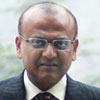No self-respecting democracy or government would have allowed her greatest painter to die in exile. India did.
Our leaders, including Prime Minister Manmohan Singh, have promptly described his demise as a "national loss". That’s a crazy and hypocritical thing to say after you did nothing to assure a man his fundamental right to life and personal liberty.
I hope there's time and occasion for redemption and MF Husain's mortal remains can be buried in the 'mitti' he loved, perhaps more than the self-appointed guardians of Hindutva.
I doubt that the Bajrang Dal types whose threats drove a liberal to sheikhdoms and monarchies like Dubai and Qatar feel some remorse. They leave the rest of us look foolish for having acquiesced. Our silence forced a harmless nonagenarian to feel more creative space amidst benevolent despots. How authentic is our claim of being the cradle of 'sarva dharma sambhaav'?
Even in death, I doubt whether the fundamentalists who converted a master into a nomad have any magnanimity or remorse. Grace demands they do. Isn't it curious that these ayatollas of Hinduism woke up to Husain’s portraits of our goddesses in the nude, at least two decades after they were painted?
Surely, all it took was just one Hindutva publication to pull out some old paintings.
I played a footnote in what could have made Husain a bigger "culprit", not just in the hands of Hindu fundamentalists, but also their opposite numbers in the Islamic world.
It so happened that the television channel where I was business editor seconded me to accompany the then Prime Minister, Atal Bihari Vajpayee, to the United Nations General Assembly. That was 1998, the year Vajpayee and Nawaz Sharief met on the sidelines and announced the famous Lahore Bus Journey. A well-regarded editor of a Hindutva publication and I were wandering around the Lexington Hotel, when we noticed MF hanging out too. For the record, he wasn’t bare feet, but in cream coloured moccasins! We learnt he was living in the same hotel, just a floor above us. Journalists being journalists, we sought an interview, which to our delight was immediately granted.
The next morning, me and the editor tip toed into Husain’s room, my cameraman Atul in tow. Husain has sketches sprawled on the floor and after minimal pleasantries we started our questions. Since I had a camera unit, the questions became my responsibility. The editor of the publication magnanimously limited himself to taking notes.
As the conversation progressed, I sensed Husain had breached political correctness. Hoping to extract a usable byte, I had asked why he had made a habit of insulting Hindu symbols. But here he had launched into a prolific explanation of his sense of balance, his plan to establish that both Hindu and Islamic structures were inspired by phallic symbols!
"Phallic symbols, excuse me!" I exclaimed in protest, jogging my memory for relevant tutorials I wish I had written for Prof Mohd Amin and Prof PS Dwivedi at my college. The painter was in no mood to relent. We spent a good ten minutes suffering his views on the phallic symbolism in Hinduism and Islam!
On my return to India, my editors weren’t remotely interested in any story that I had shot. One of them, now a close friend, looked distinctly upset at the idea of broadcasting the words 'linga' and 'yoni' on private television. Surely, those were different times and I gladly agreed to give the interview a decent burial.
By then the editor of the Hindutva publication had called me several times. He wanted the tape, lest Husain contested the interview based on notes alone. The BJP was in power, and what that publication said was often used by others. It didn’t take much to simulate how many publications would have ricocheted Husain’s considered views on phallic symbolism.
I risked my friendship with the editor, but wriggled out of such an enterprise. My excuse was that the tape is my channel’s property (I am sure it lying in their archives) and more so because it hasn’t been telecast! My instinct was that an interview like this would evoke not one but two distinct sets of death threats for Husain.
Several months later, poet Kamna Prasad asked me if I had interviewed Husain. I wondered how she knew. I then learnt that Husain had been pretty worried over the last few months over the interview he had innocently granted to two journalists who he had never met! Kamna had pieced together the details and guessed that "is tarah ki badmashi tum hi kar sakte ho!"
Husain, Kamna and I met at IIC a few days later. Husain had asked for me. Overlooking the fountain, without any conversation, Husain fetched some coloured pens from a canvass bag. Kamna mentioned something about me being a dear friend, and a happily-single-one at that! Husain didn’t have paper, so we made do with the cashier’s sheets of a dot matrix printer. In a few minutes emerged a gorgeous lady with a deer, a peacock and a banana tree. The bearers stopped, the fountain’s spray overwhelmed their step. She looked liked Shakuntala. As ever, Husain did not make eyes or any other facial features. Before I could say a word, Husain had left.
I hope the editor in my story reads this and his readers understand the protagonist a little better and forgive him for retaining the child in himself.
